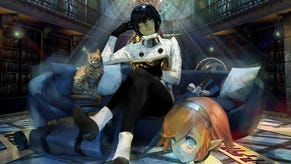Sony aims for 5 million PS4 sales in FY2013 - TGS keynote
Sony's Tokyo Game Show 2013 keynote talked up the consoles connected features and indie-friendliness, with executive Andrew House announcing a bold sales target for FY 2013.
Andrew House: PS4's positioning in a connected world
The World Created by PlayStation 4 began with a presentation called "A Day With PlayStation". A video showed a gamer chappie playing Capcom's Deep Down, and using the PS4's social features to share the experience - including via a mobile app. He exchanged messages with a couple of friends of his who were also playing games. One of these, a bright young lass, popped her Vita in her bag and went to uni, where she attended a lecture and then picked up a tank battle game right where she had left off at home.
Another Vita fan was shown playing God Eater 2 with three friends around a table, and four more were spotted using the newly-announced, Asia-only Vita TV to play a fighter at home.
The Share button was featured prominently throughout the video, as were comments and what looked like clan features. Basically, Sony was trying to communicate that the new PS4 and Vita ecosystem is a connected, social world. The presentation ended with the word "Connected", in fact.
SCE Group CEO Andrew House then took the stage, sounding pretty fluent in his very first large audience Japanese language presentation. Nice work, Andy.
Wielding the phrase "evolution of consoles", House asked what kind of role consoles can play in a connected world. He mentioned three major trends. The first is the growth of hardcore gamers who chase the latest games; he mentioned that Call of Duty: Black Ops 2 and Grand Theft Auto 5 prove console gaming is not a niche market anymore.
Secondly, House said that consoles are evolving as media and entertainment devices and can't just be game boxes any more; tablets and mobiles are related to this, he added, as gamers want a more social experience.
Finally, free-to-play games are increasingly important.
House said that it's important that consoles in the centre of the living room have a UI which will deliver games, media and social content to all members of the household, and be closely interfaced with social networks. These ideas informed the creation of the PlayStation 4.
House said game consoles were seen as "just toys" before Sony created a "mainstream" path for games. Now it's planning to do that again, building on the success of the PlayStation Network.
One way it intends to do this is to provide connectivity - with the broader Internet and with mobile devices. To this end, Sony has built a "consumer-focused", always-connected development environment. Every time a user switches on a PS4, they'll see something from the broader connected world, and much of it will be personalised for individuals. He called on developers around the world to help deliver social, connected, personalised experiences together with Sony, mixing hardcore games with karaoke and party titles.
House said games are becoming much more expensive and difficult to make - more "like Hollywood" - but Sony is committed to building a development environment which makes making games as easy as possible. He cited Sony's indie publishing philosophies.
The executive said Sony hopes to sell 5 million PS4 units by the end of FY 2013.
Having announced a whopping sales target for PS4, House moved onto other products. The Asia-only Vita TV was first, with House noting that it's targeted at new casual users in addition to existing PlayStation fans.
House also mentioned the PlayStation Cloud service, noting that Sony is still on track to bring it to North America, and noting that it will also support Vita in addition to PS4.
The presentation concluded with a slide titled "the best place to play".
Masayasu Ito: Indies, the Dual Shock 4, and instant network
SCE engineering and production division boss Masayasu Ito was next up.
The theme of Ito's speech seemed to be how PS4 has been designed to assist developers with adjusting to a new gaming world order in which mobile devices and social experiences are so important.
Mark Cerny worked with developers to ensure the new console met their needs rather than being designed in a vacuum. As a result, Sony elected to use affordable PC hardware, notably bumping up the system's RAM to 8GB of DDR5 at the request of developers.
Continuing the theme of developer relations, Ito reiterated Sony's commitment to, and program specifically design to entice, indies, as well as maintaining a "friendly" environment for providers at all levels, on both PS4 and Vita. He said content providers need the freedom to choose price, launch timing, and platform. "SCEI will always try to heed the opinions of indie developers," he said. "As a platform holder, SCEI is grateful that we have the interest of indie developers."
The presentation then cut to a showreel of independent games coming to PS4 and Vita. There were a lot of things I've forgotten the name of, but also Fez and Octodad.
Ito then moved onto the DualShock 4, highlighting its similarities to the DualShock 3, but noting its overall refinement. He also made a fuss over the Share button, the new Option key (which replaces Start and select), the capacitative touch pad and the Light Bar. Here's something cute I'd not realised; when playing multiplayer, every player gets their own colour, so there's no more fighting over which pad is which, or disastrously un-pausing to check. Ito concluded his DualShock 4 presentation by mentioning the headphone jack and speaker for sound effects.
The next topic Ito addressed was rapid network features. He said Sony wanted to ease user frustrations by making games playable as they download, and by speeding up downloads. In a similar vein, Sony wants the Share button to make uploading video and screenshots really quick and easy.
Interestingly, Ito said Sony has introduced real name identities, as opposed to nicknames or handles like the PlayStation network does now, because casual users aren't as keen on connecting socially with strangers. It's a theory; certainly the success of game requests on Facebook suggests casual users do like playing with friends. Ito stressed that real name use is optional, and is designed to expand the casual user base; hardcore fans can keep their handles.
The PS4's camera is also tied into this quest for social identity. With a simple menu, players can take a photo or video to identify themselves. It's just one of many initiatives Sony hopes will help make the PlayStation experiences tailored and customised to the individual.
PlayStation App
Ito then introduced the PlayStation App, a mobile app. SCE Worldwide Studios boss Shuhei Yoshida came on stage to perform a live demonstration using a new Xperia smartphone.
The first screen he showed was called What's New, which shows what friends are doing. Yoshida saw a friend had bought Killzone, and sent a multiplayer match request. Another friend was broadcasting gameplay, so Yoshida showed how you could link straight out to Nico Nico and other social networks to engage with that. The next page, Topics, had panels devoted to various games, events and similar.
Next, Yoshida showed off a future feature - second screen controls, like the Wii U tablet or Xbox SmartGlass. By connecting the phone to the PS4, users will be able to access new kinds of gameplay which can then be integrated into the core PS4 or Vita game. Yoshida said it's very easy for PS4 developers to use either PlayStation App or their own dedicated app to implement these features.
PlayStation and Vita TV Remote Play
Ito then introduced the world's first demonstration of Vita TV Remote Play, which was announced last week. Yoshida was seen playing Knack on PS4, with a Dual Shock. He said if he had been playing the game at home, and his wife came in and wanted to use the TV, he could pause and switch to PlayStation Vita TV.
Yoshida briefly showed off how he could manipulate the Vita's icons arrangement with the Dual Shock before initialising the Vita TV Remote Play app. Once a PS4 and Vita TV app are registered, you can seamlessly switch over to the Vita TV using your Dual Shock 4 - precisely where you left off on your PS4. It's like Vita Remote Play, only you're using another screen in your house instead of the handheld.
Ito concluded by reiterating that PlayStation can be connected to Vita, Vita TV, mobiles and tablets, and said that Sony hopes to make all these features available when the PS4 launches, although it can't guarantee it. Sony wants you to enjoy the PlayStation ecosystem both inside and outside the house, and for players to enjoy it alongside their friends and family.
"That is the kind of fun world that we hope to create," he said.
The keynote is now complete, but will be followed by the first of three stage events. Get caught up on what to watch from this year's TGS.










